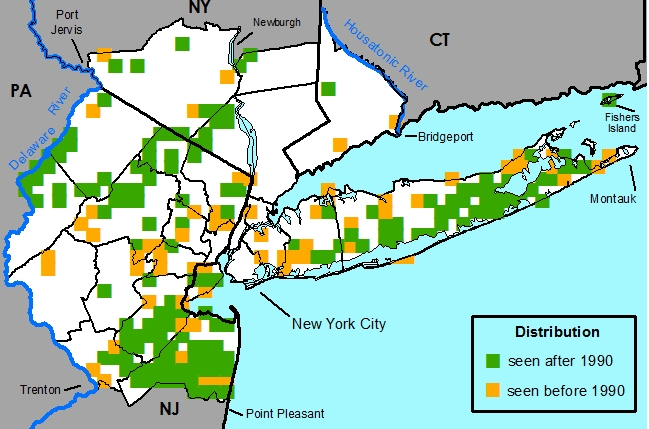Gaylussacia frondosa (L.) Torr. & A.Gray - Dangleberry
Common Names
DangleberryField Identification
A shrub with sessile resin-glands on the lower leaf surface only and blue fruit.Food uses
Disclaimer: The information provided here is for reference and historical use. We do not recommend nor do we condone the use of this species for food purposes without first consulting a physician.The fruits are edible and used in puddings.
Nomenclature
*Vaccinium frondosum L., Sp. Pl. 1: 351. 1753. *Vaccinium glaucum W. Young, Cat. Arbr. Amer. 25. 1783, nom. inval. prop (Art. 32.8). *Vaccinium glaucum Lam., Encycl. 1: 73. 1783, nom. illeg. (Art. 52.1). *Gaylussacia frondosa (L.) Torr. & A. Gray ex Torr., Fl. New York, 1: 449. 1843. *Decamerium frondosum (L.) Nutt., Trans. Amer. Phil. Soc. n.s., 8: 260. 1843. *Adnaria frondosa (L.) Kuntze, Revis. Gen. Pl. 2: 382. 1891. *Decachaena frondosa (L.) Small, Man. S.E. Fl. 1007. 1933. TYPE: Type not designated, apparently two elements.¤Vaccinium venustum Lodd., A catalogue of plants and seeds which are sold by Conrad Loddiges, London. 1777.4-1783.8. [ref. in (Ludwig, 1783)]. *Vaccinium venustum Aiton, Hort. Kew. 2: 11. 1789. TYPE: Location and collector unknown (Holotype: BM, photo: NY).
*Gaylussacia frondosa var. polycodioides Camp, Bull. Torrey Bot. Club 62: 131-132. 1935. TYPE: United States. New Jersey; S of Toms River. Collector unknown. (Holotype: NY; Isotype: GH). [large leaf-like and generally persistent bracts]
*Gaylussacia frondosa f. glaucophylla Camp, Bull. Torrey Bot. Club 62: 132. 1935. TYPE: Type not cited. [branches and upper leaf surface greenish-glaucescent]
Description
HABIT perennial, deciduous, phanerophyte or chamaephyte, shrubs, autotrophic, monoclinous, with adventitious roots and with fibrous roots, 1-2 m tall, not modified or with rhizomes.STEMS erect, round, not winged, "regular". Prickles absent. Bark striate, not exfoliating, gray and black. Branches ascending, gray, round, not winged, 1-2 mm in diam. Twigs gray, not odoriferous, round, 1 mm in diam., smooth, glabrous, glands present, glands sessile, orange. Pith present, yellowish orange, round, continuous. Thorns absent. Aerial roots absent. Sap translucent. Resin absent.
BUDS terminal and axillary buds monomorphic. Terminal bud absent. Axillary buds present, 1, ovoid, 1.7 mm long, pointed. Bud scales 2, yellowish orange, imbricate, ovate, chartaceous, acute, glabrous, without glands. Bud scale scars. Leaf scars crescent, 0.6 mm high, 1.1 mm wide, none. Vascular bundle scars 1, circular, 0.1 mm tall.
LEAVES alternate, 1 per node, spaced ± evenly along stem, divergent from stem, simple. Stipules absent. Leaves petiolate, petiole "typical", 0.2-0.35 cm long, hairs short and unbranched, spreading, unicellular, uniseriate, sparse, throughout, glabrescent, glands present, glands sessile. Leaf: abaxial surface green, adaxial surface green, blades narrowly elliptic or oblanceolate or elliptic or obovate, plane, symmetric, 1.9-7 cm long, 0.9-3.5 cm wide, chartaceous, base cuneate, margin ciliate, apex retuse or obtuse, abaxial surface glabrous, without glands, adaxial surface glabrous or hairs short and unbranched, spreading, unicellular, uniseriate, white, sparse, along midveins, glabrescent, glands present, glands sessile, orange. Brochidodromous venation, veins 6-7. Leaf lobes absent. Spines absent. Tendrils absent.
INFLORESCENCES monomorphic, regular or, if dimorphic, female inflorescence simple, raceme, axillary. Peduncle present, 0.5-1.3 cm long. Rachis present, 3.3-4.4 cm long, with bracts. Bracts sessile, blades: abaxial surface green, adaxial surface green, narrowly elliptic, plane, 3-7 mm long, 1-2.7 mm wide, base cuneate, margin ciliate, apex acute or obtuse, abaxial surface glabrous, glands present, glands sessile, orange, adaxial surface glabrous, without glands. Pedicel 7-13 mm long, glabrous, without glands. Bracteoles 2, sessile, other (variable), not connate, bracteoles: abaxial surface orange, bracteole: adaxial surface orange, linear, curved, 1.7 mm long, 0.1 mm wide, base cuneate, margin ciliate, apex acute. Cupules absent.
FLOWERS serotinous, formed on long shoots, monomorphic, with sepals and petals readily distinguishable from one another, bisexual. Perfect or female flowers white, 5-merous, 4-4.5 mm long, 3-4.5 mm wide, 6-9 flowers per inflorescence, perianth of two whorls. Calyx present, actinomorphic, campanulate, of fused sepals, persistent, 2-2.2 mm long, 2.1 mm wide, tube 1-1.1 mm long, calyx limb 0.8-0.9 mm long, 2.1 mm wide. Sepals or sepal lobes 5, depressed ovate, 0.8-0.9 mm long, 1.4 mm wide, base truncate, margin entire or ciliate, apex acute or obtuse, abaxial surface glabrous, glands present, glands sessile, orange, adaxial surface glabrous, glands present, glands sessile, orange. Epicalyx absent. Corolla present, actinomorphic, urceolate, of fused petals, deciduous, abaxial and adaxial surfaces the same color, white, 3-7 mm long, 1-2.7 mm wide, corolla limb 0.3 mm long, 3.7 mm wide. Petals or petal lobes 5, shallowly deltate, 0.8 mm long, 1 mm wide, base truncate, margin entire, apex acute, abaxial surface glabrous, without glands, adaxial surface glabrous, without glands. Gynoecium syncarpous. Carpels 5. Stigmas 1, capitate. Styles not persistent, 1, 4.2 mm long. Ovary inferior, 1.1 mm long, 1.6 mm wide, nectiferous disk present. Locules 10. Placentation axile. Androecium obdiplostemonous. Stamens 10, 3.5-3.6 mm long. Anthers elongate, opening by pores, bithecal, orange, minutely papillose. Filaments free, straight, orange, glabrous. Staminodes absent.
FRUITS a bacca (berry), blue, globose, 9-10 mm long, 9-10 mm wide, glabrous, without glands.
SEEDS 10, orange, ovoid, 1.8-2.2 mm long, 1.5-1.7 mm wide, wingless, not tailed, rugose.
Habitat
Swamps (pine swamps, magnolia swamps, chamaecyparis swamps, cranberry bogs), woods (white pine forest, oak woods and barrens, mesic forest), and thickets. Wet sphagnum peat, moist and dry upland peat.
Rarity Status
Heritage global rank -- G5Connecticut -- not listed
New Jersey --not listed
New York -- not listed
Species Biology
FloweringMay [week 2] - July [week 2].
Pollination
Unknown.
Fruiting
July [week 1] - Nov [week 1].
Dispersal
(Vines, 1960)Endozoochory -- The fruit is eaten by a number of species of birds, including cedar waxwing, bobwhite quail, and ruffed grouse.
Germination
Unknown.
